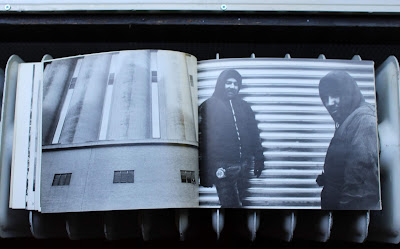14th St. : Photographs by Sy Rubin & Larry Siegel
Sy Rubin and Larry Siegel); Paul Goldberger (Introduction)
ISBN 10: 093655410X / ISBN 13: 9780936554105
Published by Matrix, Providence, Rhode Island, 1982
96 pages; over 70 b&w photos of life on 14th St. when rents were lower and condos hadn't yet arrived. Paul Goldberger is a longtime architectural critic, notably with the New York Times. Size: Oblong 8vo.
See also
Views & Reviews New York in Photobooks from William Klein through to Bruce Golden Horacio Fernández Photography
Top Classic Photobooks about New York City according to AddAll Photography
14th St.
Street photography was well established as a genre in New York by the seminal work of William Klein and Robert Frank in the 1950s. The tradition was transformed in the 1970s through the more personal work of photographers like Diane Arbus and Garry Winogrand. Perhaps the best-known example of this newer kind of personal documentary work, applied to a specific neighborhood in New York, is Bruce Davidson’s East 100th Street project, funded by an NEA grant in 1966–1968 and published in book form in 1970. From 1976 to 1981, the NEA supported more than 70 projects documenting American cities. One such project, Sy Rubin and Larry Siegel’s 14th St., demonstrates the continuing vitality of street photography into the late 1970s and early 1980s.
Sponsored by the Midtown Y and funded in part by the NEA and the J. M. Kaplan Fund, the project documented Manhattan’s longest crosstown street, which was then considered the dividing line between downtown and midtown. Running from the Con Edison plant at the East River to the meatpacking district near the Hudson, 14th Street was, and still is, home to the “Y.” Although much of the flavor of 14th Street remains today, many of the once familiar places Rubin and Siegel captured have since disappeared: May’s Department Store is now the site of a Whole Foods Market, and Lüchow’s restaurant, the Palladium, and Julian’s Billiards have been replaced by buildings owned by New York University, which now has a dominant presence in the East Village. On the West Side, the meatpacking district has undergone perhaps an even more extreme transformation and is now home to high-end fashion boutiques and trendy restaurants.
The photographs in this section are gelatin silver prints by Sy Rubin (1931–2002), taken between 1979 and 1981 and donated by Rubin to the permanent collection of the Midtown Y Photography Gallery. They were included in the exhibition 14th St., on display at the Midtown Y from February 17 to March 21, 1982, and published in a book of the same title in 1982. They are presented here in the original exhibition order designated by Rubin.
Sy Rubin. “Union Square Sub-way Station.” Gelatin silver print, included in the exhibition 14th St., February 17–March 21, 1982, and published in 14th St. (Providence, R.I.: Matrix, 1982). © Andrew M. Rubin; reproduced courtesy of Andrew M. Rubin, Jennifer Rothschild, and Judith Rubin.
Sy Rubin. “Corner of Third Avenue.” Gelatin silver print, included in the exhibition 14th St., February 17–March 21, 1982, and published in 14th St. (Providence, R.I.: Matrix, 1982). © Andrew M. Rubin; reproduced courtesy of Andrew M. Rubin, Jennifer Rothschild, and Judith Rubin.
Sy Rubin. “Between Fifth Avenue and Avenue of the Americas.” Gelatin silver print, included in the exhibition 14th St., February 17 – March 21, 1982, and published in 14th St.(Providence, R.I.: Matrix, 1982). © Andrew M. Rubin; reproduced courtesy of Andrew M. Rubin, Jennifer Rothschild and Judith Rubin.
Sy Rubin. “14th Street Subway Station.” Gelatin silver print, included in the exhibition 14th St., February 17–March 21, 1982, and published in 14th St. (Providence, R.I.: Matrix, 1982). © Andrew M. Rubin; reproduced courtesy of Andrew M. Rubin, Jennifer Rothschild, and Judith Rubin.


































Geen opmerkingen:
Een reactie posten